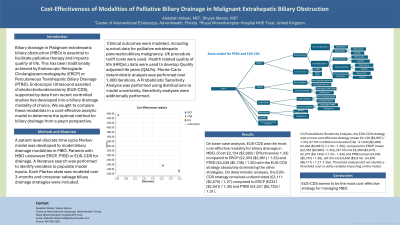Monday Poster Session
Category: Biliary/Pancreas
P1753 - Cost-Effectiveness of Modalities of Palliative Biliary Drainage in Malignant Extrahepatic Biliary Obstruction
Monday, October 28, 2024
10:30 AM - 4:00 PM ET
Location: Exhibit Hall E

Has Audio

Abdullah Abbasi, MBBS, MD, MRCP
Centre of Interventional Endoscopy at AdventHealth
Orlando, FL
Presenting Author(s)
Award: Presidential Poster Award
Shyam Menon, MSc, MD, MBA1, Abdullah Abbasi, MBBS, MD, MRCP2
1The Royal Wolverhampton NHS Trust, Wolverhampton, England, United Kingdom; 2Centre of Interventional Endoscopy at AdventHealth, Orlando, FL
Introduction: Biliary drainage in Malignant extrahepatic biliary obstruction (MBO) is essential to facilitate palliative therapy and impacts quality of life. This has been traditionally achieved by Endoscopic Retrograde Cholangiopancreatography (ERCP) or Percutaneous Transhepatic Biliary Drainage (PTBD). Endoscopic Ultrasound assisted choledochoduodenostomy (EUS-CDS), supported by data from recent controlled studieshas developed into a biliary drainage modality of choice. We sought to compare these modalities in a cost-effective analytic model to determine the optimal method for biliary drainage from a payor perspective.
Methods: A patient level discrete time cycle Markov model was developed to model biliary drainage modalities in MBO. Patients with MBO underwent ERCP, PTBD or EUS-CDS for drainage. A literature search was performed to identify variables to populate model inputs. Each Markov state was modeled over 3-months and crossover salvage biliary drainage strategies were included. Clinical outcomes were modeled, including survival data for palliative extrahepatic pancreaticobiliary malignancy. UK procedure tariff costs were used. Health related quality of life (HRQoL) data were used to develop Quality adjusted life years (QALYs). Monte-Carlo deterministic analysis was performed over 1,000 iterations. A Probabilistic Sensitivity Analysis was performed using distributions to model uncertainty. Sensitivity analyses were additionally performed.
Results: On base-case analysis, EUS-CDS was the most cost-effective modality for biliary drainage in MBO, (Cost £2,124 ($2,692) / Effectiveness 1.33) compared to ERCP (£2,353 ($2,981) / 1.33) and PTBD (£4,536 ($5,748) / 1.30) with the EUS-CDS strategy absolutely dominating the other strategies. On deterministic analysis, the EUS-CDS strategy remained undominated (£2,111 ($2,675) / 1.37) compared to ERCP (£2321 ($2,941) / 1.36) and PTBD (£4,521 ($5,729) / 1.31). On Probabilistic Sensitivity Analysis, the EUS-CDS strategy was a more cost effective strategy (mean £2,128 ($2,697) / 1.33), 97.5% confidence intervals (CIs) : £1,943 ($2,462) - £2,444 ($3,097)) / (1.33 – 1.35)), compared to ERCP (mean (£2,352 ($2,980) / 1.33)), (97.5% CIs £2,269 ($2,875) - £2,473 ($3,134)) / (1.33 – 1.34)) and PTBD (mean £4,535 ($5,747) / 1.30), (97.5% CIs £4,430 ($5,614) - £4,870 ($6,171) / 1.27 -1.35)). Threshold analysis did not identify a threshold cost or utility variable impacting on the model.
Discussion: EUS-CDS seems to be the most cost-effective strategy for managing MBO.
Disclosures:
Shyam Menon, MSc, MD, MBA1, Abdullah Abbasi, MBBS, MD, MRCP2. P1753 - Cost-Effectiveness of Modalities of Palliative Biliary Drainage in Malignant Extrahepatic Biliary Obstruction, ACG 2024 Annual Scientific Meeting Abstracts. Philadelphia, PA: American College of Gastroenterology.
Shyam Menon, MSc, MD, MBA1, Abdullah Abbasi, MBBS, MD, MRCP2
1The Royal Wolverhampton NHS Trust, Wolverhampton, England, United Kingdom; 2Centre of Interventional Endoscopy at AdventHealth, Orlando, FL
Introduction: Biliary drainage in Malignant extrahepatic biliary obstruction (MBO) is essential to facilitate palliative therapy and impacts quality of life. This has been traditionally achieved by Endoscopic Retrograde Cholangiopancreatography (ERCP) or Percutaneous Transhepatic Biliary Drainage (PTBD). Endoscopic Ultrasound assisted choledochoduodenostomy (EUS-CDS), supported by data from recent controlled studieshas developed into a biliary drainage modality of choice. We sought to compare these modalities in a cost-effective analytic model to determine the optimal method for biliary drainage from a payor perspective.
Methods: A patient level discrete time cycle Markov model was developed to model biliary drainage modalities in MBO. Patients with MBO underwent ERCP, PTBD or EUS-CDS for drainage. A literature search was performed to identify variables to populate model inputs. Each Markov state was modeled over 3-months and crossover salvage biliary drainage strategies were included. Clinical outcomes were modeled, including survival data for palliative extrahepatic pancreaticobiliary malignancy. UK procedure tariff costs were used. Health related quality of life (HRQoL) data were used to develop Quality adjusted life years (QALYs). Monte-Carlo deterministic analysis was performed over 1,000 iterations. A Probabilistic Sensitivity Analysis was performed using distributions to model uncertainty. Sensitivity analyses were additionally performed.
Results: On base-case analysis, EUS-CDS was the most cost-effective modality for biliary drainage in MBO, (Cost £2,124 ($2,692) / Effectiveness 1.33) compared to ERCP (£2,353 ($2,981) / 1.33) and PTBD (£4,536 ($5,748) / 1.30) with the EUS-CDS strategy absolutely dominating the other strategies. On deterministic analysis, the EUS-CDS strategy remained undominated (£2,111 ($2,675) / 1.37) compared to ERCP (£2321 ($2,941) / 1.36) and PTBD (£4,521 ($5,729) / 1.31). On Probabilistic Sensitivity Analysis, the EUS-CDS strategy was a more cost effective strategy (mean £2,128 ($2,697) / 1.33), 97.5% confidence intervals (CIs) : £1,943 ($2,462) - £2,444 ($3,097)) / (1.33 – 1.35)), compared to ERCP (mean (£2,352 ($2,980) / 1.33)), (97.5% CIs £2,269 ($2,875) - £2,473 ($3,134)) / (1.33 – 1.34)) and PTBD (mean £4,535 ($5,747) / 1.30), (97.5% CIs £4,430 ($5,614) - £4,870 ($6,171) / 1.27 -1.35)). Threshold analysis did not identify a threshold cost or utility variable impacting on the model.
Discussion: EUS-CDS seems to be the most cost-effective strategy for managing MBO.
Disclosures:
Shyam Menon indicated no relevant financial relationships.
Abdullah Abbasi indicated no relevant financial relationships.
Shyam Menon, MSc, MD, MBA1, Abdullah Abbasi, MBBS, MD, MRCP2. P1753 - Cost-Effectiveness of Modalities of Palliative Biliary Drainage in Malignant Extrahepatic Biliary Obstruction, ACG 2024 Annual Scientific Meeting Abstracts. Philadelphia, PA: American College of Gastroenterology.

